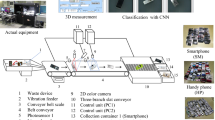Abstract
Waste is an important part of human life and possibly be a serious issue for health and the environment if there is no proper deal. In this paper, the authors develop an Android mobile application for waste classification using EfficientNet-Lite model from TensorFlow Lite. The model is trained and validated using a dataset containing 15,190 images from 11 classes: cardboard, paper, glass, metal, electronics, battery, plastic, textile, shoes, organic, and trash. The model is evaluated using 655 images from the testing dataset and it is produced an accuracy of 95.39%. The model training and validation are done in Google Colab (Python). The model is then used as a classifier for an Android application. The application is named Leboh and developed for Indonesian speakers. The user testing of the Android application obtains an accuracy of 82.5%. Based on user testing, the quantity of plastic waste is higher than other types. EfficientNet-Lite successfully works well to classify municipal solid waste and runs fast on mobile devices.
Access this chapter
Tax calculation will be finalised at checkout
Purchases are for personal use only
Similar content being viewed by others
References
Wilson, D.C., et al.: Global Waste Management Outlook. ISWA, Vienna (2015)
Yang, M., Thung, G.: Classification of trash for recyclability status, Technical report, pp. 1–6 (2016). https://cs229.stanford.edu/proj2016/report/ThungYang-ClassificationOfTrashForRecyclabilityStatus-report.pdf
Mittal, G., Yagnik, K.B., Garg, M., Krishnan, N.C.: SpotGarbage: smartphone app to detect garbage using deep learning. In: ACM International Joint Conference on Pervasive and Ubiquitous Computing, pp. 940–945. ACM, Heidelberg (2016)
Satvilkar, M.: Image based trash classification using machine learning algorithms for recyclability status. Technical report, School of Computing National College of Ireland (2018)
Kokoulin, A.N., Tur, A.I., Yuzhakov, A.A.: Convolutional neural networks application in plastic waste recognition and sorting. In: Conference of Russian Young Researchers in Electrical and Electronic Engineering (EIConRus), pp. 1094–1098. IEEE, Moscow and St. Petersburg (2018)
Bobulski, J., Kubanek, M.: Waste classification system using image processing and convolutional neural networks. In: Rojas, I., Joya, G., Catala, A. (eds.) IWANN 2019. LNCS, vol. 11507, pp. 350–361. Springer, Cham (2019). https://doi.org/10.1007/978-3-030-20518-8_30
Frost, S., Tor, B., Agrawal, R., Forbes, A.G.: CompostNet: an image classifier for meal waste. In: Proceeding of IEEE Global Humanitarian Technology Conference (GHTC), Seattle, WA. IEEE (2019)
Vo, A.H., Son, L.H., Vo, M.T., Le, T.: A novel framework for trash classification using deep transfer learning. IEEE Access 7, 178631–178639 (2019). https://doi.org/10.1109/ACCESS.2019.2959033
Nowakowski, P., Pamuła, T.: Application of deep learning object classifier to improve e-waste collection planning. Waste Manage. 109, 1–9 (2020). https://doi.org/10.1016/j.wasman.2020.04.041
Shi, C., Tan, C., Wang, T., Wang, L.: A waste classification method based on a multilayer hybrid convolution neural network. Appl. Sci. 11, 1–19 (2021). https://doi.org/10.3390/app11188572
Deng, Y.: Deep learning on mobile devices - a review (2019). https://arxiv.org/abs/1904.0927
Machine learning for mobile developers. https://developers.google.com/ml-kit
Abadi, M., et al.: TensorFlow Large-Scale Machine Learning on Heterogeneous Systems (2006). https://www.tensorflow.org/
Pudaruth, S., Mahomoodally, M.F., Kissoon, N., Chady, F.: MedicPlant: a mobile application for the recognition of medicinal plants from the Republic of Mauritius using deep learning in real-time. IAES Int. J. Artif. Intell. (IJ-AI) 10, 938–947 (2021). https://doi.org/10.11591/ijai.v10.i4.pp938-947
Nasir, H.M., Brahin, N.M.A., Aminuddin, M.M.M., Mispan, M.S., Zulkifli, M.F.: Android based application for visually impaired using deep learning approach. IAES Int. J. Artif. Intell. (IJ-AI) 10, 879–888 (2021). https://doi.org/10.11591/ijai.v10.i4.pp879-888
LeCun, Y., Bengio, Y., Hinton, G.: Deep learning. Nature 521, 436–444 (2021). https://www.nature.com/articles/nature14539
Keras. https://keras.io
Szegedy, C., et al.: Going deeper with convolutions. In: Conference on Computer Vision and Pattern Recognition (CVPR), Boston, MA. IEEE (2015)
Ioffe, S., Szegedy, C.: Batch normalization: accelerating deep network training by reducing internal covariate shift. Proc. Mach. Learn. Res. 37, 448–456 (2015)
Szegedy, C., Vanhoucke, V., Ioffe, S., Shlens, J., Wojna, Z.: Rethinking the inception architecture for computer vision. In: Conference on Computer Vision and Pattern Recognition, Las Vegas. IEEE (2016)
Simonyan, K., Zisserman, A.: Very deep convolutional networks for large-scale image recognition (2015). https://arxiv.org/abs/1409.1556
Russakovsky, O., et al.: ImageNet large scale visual recognition challenge. Int. J. Comput. Vision 115(3), 211–252 (2015). https://doi.org/10.1007/s11263-015-0816-y
He, K., Zhang, X., Ren, S., Sun, J.: Deep residual learning for image recognition. In: Conference on Computer Vision and Pattern Recognition (CVPR). IEEE, Las Vegas (2016)
He, K., Zhang, X., Ren, S., Sun, J.: Identity mappings in deep residual networks. In: Leibe, B., Matas, J., Sebe, N., Welling, M. (eds.) ECCV 2016. LNCS, vol. 9908, pp. 630–645. Springer, Cham (2016). https://doi.org/10.1007/978-3-319-46493-0_38
Chollet, F.: Xception: deep learning with depthwise separable convolutions. In: Conference on Computer Vision and Pattern Recognition (CVPR). IEEE, Honolulu (2017)
Huang, G., Liu, Z., Maaten, L.V.D., Weinberger, K.Q.: Densely connected convolutional networks. In: Conference on Computer Vision and Pattern Recognition (CVPR). IEEE, Honolulu (2017)
Howard, A.G., et al.: MobileNets: efficient convolutional neural networks for mobile vision applications (2017). https://arxiv.org/abs/1704.04861
Sandler, M., Howard, A., Zhu, M., Zhmoginov, A., Chen, L.C.: MobileNetV2: inverted residuals and linear bottlenecks. In: Conference on Computer Vision and Pattern Recognition (CVPR), pp. 4510–4520. IEEE, Salt Lake City (2018)
Zoph, B., Vasudevan, V., Shlens, J., Le, Q.V.: Learning transferable architectures for scalable image recognition. In: Conference on Computer Vision and Pattern Recognition, pp. 8697–8710. IEEE, Salt Lake City (2018)
Tan, M., Le, Q.: EfficientNet: rethinking model scaling for convolutional neural networks. In: Proceedings of Machine Learning Research, pp. 6105–6114. PMLR (2019)
Wang, A.: EfficientNet-Lite (2021). https://github.com/tensorflow/tpu/tree/master/models/official/efficientnet/lite
Acknowledgment
This paper was supported by research funding from Lembaga Penelitian dan Pengabdian kepada Masyarakat Universitas Tarumanagara, No 1689-Int-KLPPM/UNTAR/XI/2021.
Author information
Authors and Affiliations
Corresponding author
Editor information
Editors and Affiliations
Rights and permissions
Copyright information
© 2023 The Author(s), under exclusive license to Springer Nature Switzerland AG
About this paper
Cite this paper
Handhayani, T., Hendryli, J. (2023). Leboh: An Android Mobile Application for Waste Classification Using TensorFlow Lite. In: Arai, K. (eds) Intelligent Systems and Applications. IntelliSys 2022. Lecture Notes in Networks and Systems, vol 544. Springer, Cham. https://doi.org/10.1007/978-3-031-16075-2_4
Download citation
DOI: https://doi.org/10.1007/978-3-031-16075-2_4
Published:
Publisher Name: Springer, Cham
Print ISBN: 978-3-031-16074-5
Online ISBN: 978-3-031-16075-2
eBook Packages: Intelligent Technologies and RoboticsIntelligent Technologies and Robotics (R0)




